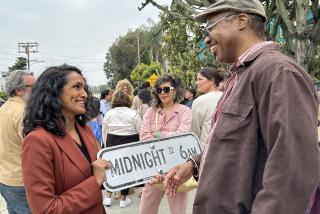Signs Signal ‘No’ at Us Across U.S.
- Share via
Driving across America with a camera is a lesson in self-discovery. A camera gives a traveler a reason to stop the car, explore and a chance to meet people. But it was the preponderance of no signs that caught my eye during several journeys from California through the Rockies and Great Plains, the Atlantic seaboard and New England.
No signs are everywhere. There’s no escaping them. They lurk at us from walls, windows, doors, buildings, fences, trucks, roads and even trees.
They are posted at gas stations, train stations, ports, airports and bus depots, lingering about in cold bold, striking red and scrawled letters. They come in assorted shapes and sizes, with misspellings and faded colors.
No signs are, in a sense, signs of the times, penned by pundits, poets, philosophers, would-be comics and hard-working merchants. They are as varied as America is diverse in dialects, a kind of sociological yardstick. And beneath their texture of metal, wood, plastic, concrete, cardboard or plain paper is a fabric of personalities.
A no sign embodies more than its literal message.
What kind of person tells us “No parking. If you park in my driveway I will flatten your tires”? Or “Sorry, No Free Matches”? Or “No Shopping Bags Allowed in the Store. We Know all the Tricks. Please leave them on the Counter”? Or “No Change Without Purchase”? These folks are grouches, forever frowning, people who aren’t going to make your day.
Fun-Loving People
In contrast are the upbeats, the fun-loving people who create signs like: “No I.D., No Alcohol, No Argument” (liquor store). “We Give Change With a Smile, No Purchase Necessary” (coffee shop). “No Dogs, Vicious Gardener, Please Keep Gate Closed” (bed-and-breakfast inn).
When I met the maker of the no sign, it was usually in a place of business. Most signs are straight-forward--”No Food,” “No Smoking.” And most retailers are serious types, except the antique dealer in West Stockbridge, Mass., who satirizes the concept of no signs. Taped to his glass door was one that read:
“No Bear Feet
No Bare Feet
No ‘My Grandmother Had One of These’
No White Belts
Restrictions Subject to Change Without Notice”
Most shopkeepers let me photograph their no signs without any problems. Often I asked first, but many times I didn’t. And sometimes the person in charge opposed.
How absurd! The sign is for the public, the customer, the client, for everyone, yet why not for a camera?
Hostile Attendant
Once a parking garage attendant in New York City became hostile as I snapped “No Substitution of Car on Monthly Storage.” Nor was it a joking matter when the clerk in a magazine shop refused my request to click “No Comic Book Reading.”
I saw these signs and hundreds of others while driving and walking in cities and the country, strolling beaches, roaming shopping centers, wandering into buildings and stores. On several occasions I felt as if a magnet were pulling me to some unusual no sign.
Once I made a wrong turn onto a gravel road in New York state and came upon “No Permanent Plantings” wired to a cemetery gate; walking into one of any number of public washrooms in Ephrata, Pa., I saw “No Loafing” on the tiled wall; pulling into a truck stop cafe in Reno on Interstate 80 I found “No Doggie Bags for Buffet.”
These examples are seriously intended signs, yet there is something inherently funny about them at second glance.
No signs came to my attention, also, through a second source. San Francisco columnist Herb Caen mentioned this sign in a hamburger place in Sacramento:
“Summer Rules
Boys--No Shirt, No Service
Girls--No Shirt, No Charge”
He named the diner but not the address. So on impulse, I drove up from San Francisco and took one of the “business district” offramps at random, not knowing exactly where I wanted to go.
A Stroke of Luck
I stopped at a telephone booth, took Caen’s crumpled clipping from my wallet where it had been lodged for a year, and called information for the address. (No directory in the booth.)
Looking at the street sign to get my bearings, I saw that I was right in front of the diner I wanted. Was that coincidence? The place was closed, but I shot the sign through a side window where it hung facing the counter stools.
It is the quirkiness of these no signs across America that appeals to my photographer’s eye, yet it is the subject matter taken collectively that is similar, perhaps to my own nature, serious and silly.
After photographing more than 300 no signs I saw a certain picture of America emerge. I edited the selection to 150 photographs with the idea of producing a book. I know no .
And I’ve learned not to take “no” for an answer. For virtually every publisher rejected my submission, until one day in May, 1985.
Eventually, my travels cross-country with a camera helped to discover a positive side of no.
More to Read
Sign up for The Wild
We’ll help you find the best places to hike, bike and run, as well as the perfect silent spots for meditation and yoga.
You may occasionally receive promotional content from the Los Angeles Times.






